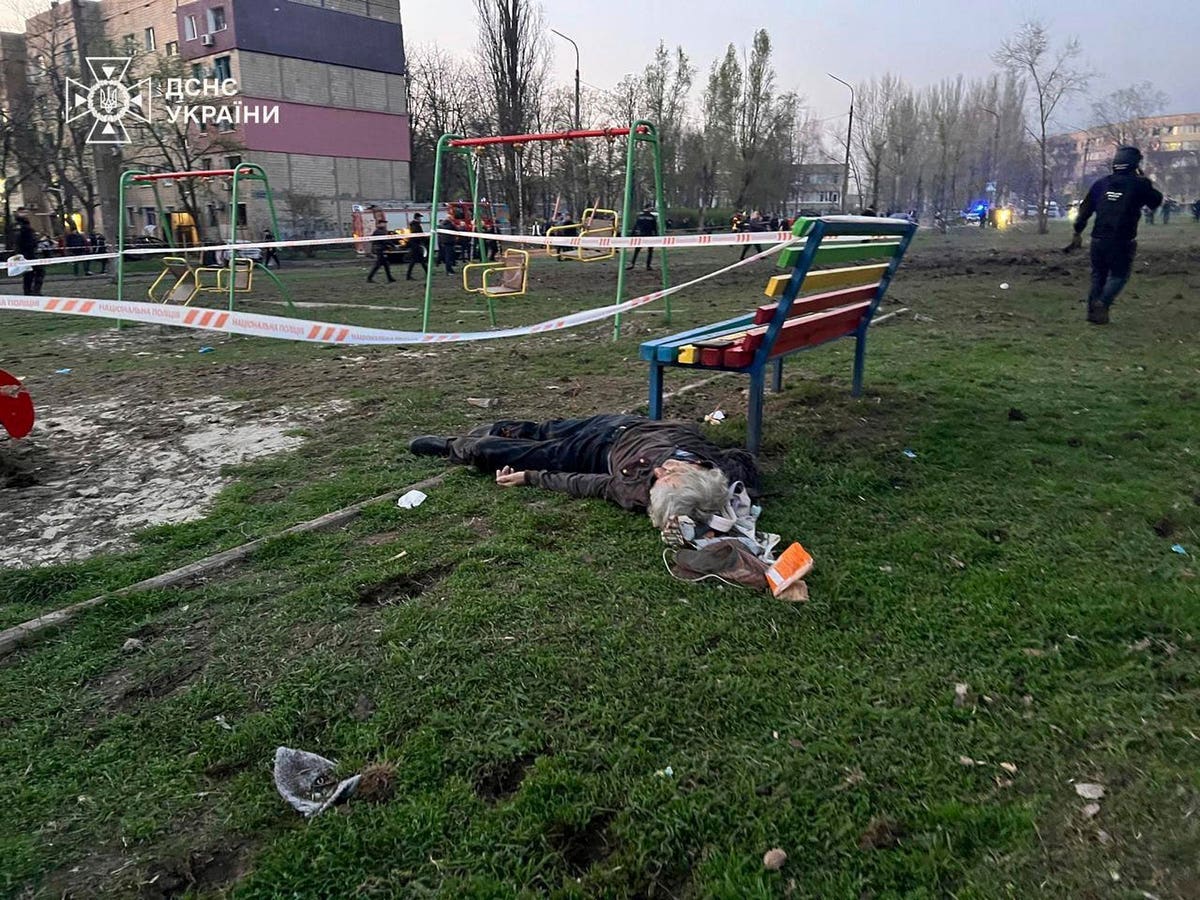EDS NOTE: GRAPHIC CONTENT – In this photo provided by the Ukrainian Emergency Service, dead bodies … More lie on the ground after a Russian missile hit apartment houses and a playground, killing 14 civilians including six children, in Kryvyi Rih, Ukraine, Friday, April 4, 2025. (Ukrainian Emergency Service via AP)
Ukrainian Emergency Service via AP
Dispatches from Ukraine. Day 1,136.
Kryvyi Rih. On April 4, Russia launched a ballistic missile attack on a residential area in Kryvyi Rih, Dnipropetrovsk Oblast, killing at least 16 people, including six children, and injuring over 50, Governor Serhii Lysak reported.
Kharkiv. Russia launched a barrage of drones in an overnight attack on Friday, killing at least four people and injuring 35 civilians in a residential area of Ukraine’s second-largest city.
Dnipropetrovsk region. A Russian ballistic missile strike on an industrial facility in Kryvyi Rih on April 2 in central Ukraine killed four people.
Zaporizhzhya region. A Russian drone strike on April 1 in Ukraine’s southern province killed one civilian.
Donetsk region. On April 2, Russian forces launched multiple strikes on residential areas in the front line city of Pokrovsk, killing one civilian and wounding six others.
A Russian Tupolev Tu-22M3 strategic bomber crashed on April 2 in the country’s eastern Irkutsk region. Before 2022, Moscow had nearly 60 of these Cold War-era warplanes, designed to carry cruise missiles and nuclear warheads. The latest crash is the fifth confirmed loss for Russia’s strategic air forces and the first since August, 2024.
Russia captured nearly 50 square miles of Ukrainian territory in March, marking the slowest advance since last summer. Although the pace of the Kremlin’s gains has slowed since its peak of 280 square miles captured last November, the land captured in March is nearly equal to the territorial gains of the first quarter of 2024. Russia’s gains have been concentrated in eastern Donetsk and Luhansk provinces and the southern Zaporizhzhya region.
Russian media outlet Mediazona, in collaboration with BBC News Russian, has confirmed more than 100,000 Russian military deaths in the war in Ukraine. The outlet’s methodology, based on analysis of publicly available sources such as social media and local reports, reveals a far higher toll than Kremlin figures, with nearly 3,000 new deaths documented every two weeks. Mediazona’s experts estimate that available data accounts for only 45–65% of the Kremlin’s actual military death toll.
In an interview last week with European news channels, Ukrainian President Volodymyr Zelenskyy declared that Russian President Vladimir Putin “will soon die and that’s a fact.” Zelenskyy did not explain what his prediction involved but said that it was “dangerous” for the United States to ease pressure on Russia with an end to the war so close.
U.S. Defense Secretary Peter Hegseth will not attend next week’s Ramstein-format meeting of Ukraine’s partners in Brussels, marking the first absence of a Pentagon chief since the format’s establishment in 2022. The summit, co-chaired by the U.K. and Germany on April 11, will proceed without Hegseth, who will not participate even virtually. His absence aligns with U.S. President Donald Trump’s strategy of reducing U.S. support for Ukraine while pursuing a ceasefire and peace treaty between Kyiv and Moscow. Hegseth, who attended the previous Ramstein summit in February, has expressed a change in U.S. policy, which now views Ukraine’s return to pre-2014 borders and NATO membership as unrealistic.
Moscow plans to increase its military forces by 150,000 personnel in 2025. According to Pavel Palisa, Deputy Head of the Office of the President of Ukraine, Russia has no difficulty recruiting personnel for this buildup but will not deploy them all at once. Instead, he stated, Russia is likely to intensify pressure on specific fronts where feasible, particularly as discussions on a ceasefire continue. Nonetheless, Russia remains largely uninterested in halting the conflict aside from potential naval considerations.
Ukraine has received $3.8 billion in aid from the European Union under the Ukraine Facility program. With the latest disbursement, total EU support has reached $21.6 billion. The funding comes as Kyiv continues reforms in anti-corruption and fiscal governance. Additionally, the European Bank for Reconstruction and Development will provide Ukraine $1 billion in 2025 to rebuild its power infrastructure, left in limbo since the halt of USAID funding. Ukraine also is awaiting a further delivery of F-16 jets from Europe.
Russia’s oil and gas revenues decreased for a second consecutive month, falling 17% since March, 2024, to $11.6 billion, as U.S. sanctions continue to restrict the Kremlin’s key income source. With crude exports facing discounts and the ruble appreciating nearly 15% against the dollar since early 2024, Moscow’s dollar-denominated energy earnings have significantly declined. The Russian finance ministry now faces a widening fiscal gap, with the country’s benchmark crude oil blend known as Urals trading nearly 30% below budget projections. Economists warn that this shortfall, which could reach $21.5 billion this year, might compel the Kremlin either to deplete its dwindling sovereign wealth fund or devalue the ruble.
Culture Front.
Russian forces have destroyed or damaged at least 1,419 cultural sites and 2,233 cultural infrastructure objects across Ukraine. The most considerable damage has been caused in the eastern and southern Kharkiv and Kherson regions, where 329 and 279 cultural sites, respectively, were damaged. Accurate estimates of the destruction in the occupied territories, however, remain difficult as Russian forces continue to deny independent experts access to the sites.
By Danylo Nosov, Alan Sacks
